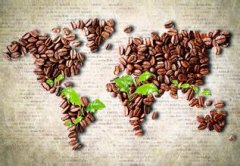Common sense of Coffee Culture Coffee's "History of aggression" to Human beings II
and spread worldwide.

The widespread popularity of coffee in Europe also brought some problems. A large number of imported coffee beans caused a large amount of foreign exchange losses. In addition, the freedom of speech in cafes threatened the rule of the authorities. At that time, the rulers of European countries first adopted the method of "throttling", closing cafes and prohibiting people from drinking coffee. However, coffee and cafes have become a trend and repeated prohibitions, so "open source" has become a more suitable choice for the situation. However, the climate of the European continent was not suitable for coffee growth, so European empires in the period of colonial expansion began to target their own colonies, opening up coffee producing areas in tropical areas of Asia, Africa and Latin America.
Introduction to Asia
Coffee seedlings shipped by the Dutch to Holland in 1616 could not be planted on a large scale because they could not adapt to the cold climate in the north, so the Dutch transplanted them to Ceylon in 1696 and Jakarta in Indonesia in 1699. Indonesia became the first country in Asia to produce coffee on a large scale.
into Central and South America.
In the 1820s, French naval officer De Keli transported a coffee sapling to Martinique in Central America, and Martinique's coffee saplings were transmitted to Haiti, Dominica and other Central American island countries.
At the same time, coffee seedlings were transmitted from Britain to Cuba and Jamaica.
Coffee is also grown on a large scale in Guyane française, Suriname and Haiti.
Spain has coffee plantations in its possessions, such as Colombia and Peru.
Coffee seedlings spread from Guyane française to Brazil, where the coffee industry jumped to become the world's largest producer at the beginning of the 20th century.
into Africa.
At the end of the 19th century, coffee was widely cultivated in British colonies in Africa. In 1893, Ethiopia's neighboring Kenya coffee industry began to develop and quickly developed into a high-quality coffee producing country.
into Hawaii.
Coffee was introduced to the Hawaiian Islands in 1825.
Introduction to Australia
Coffee was first introduced to Australia in the 1880s.
Coffee was introduced to Hawaii in 1925.
At this point, led by Brazil, with the Tropic of Cancer as the boundary, across the earth from east to west, extending to Asia, Africa, the United States and Australia coffee planting territory formed.
Coffee spread in China
In 1884, the British first introduced coffee to Taiwan, and Taiwan began to grow coffee. During the Japanese occupation, coffee began to flourish in Taiwan.
French missionaries brought coffee from Vietnam to Binchuan County in Yunnan Province in 1892, which is the earliest record of coffee cultivation in the mainland of China. At present, coffee cultivation in China is mainly concentrated in Yunnan and Hainan.
The history of coffee drinking in China can be traced back to the late Qing Dynasty. With the opening of the country, coffee began to appear in the eastern coastal cities. In the late Qing Dynasty, there were records about coffee in poetry, such as the bamboo branch word "Kaofei" popular on Shanghai Beach at that time: Kaofei what was called together, the city passed down beans made. Color sweet with bitter sugar, Westerners every food on behalf of tea cooking. In the 1920s and 1930s, there were some cafes in old Shanghai and Kunming. At the beginning of the founding of New China, coffee and cafes temporarily disappeared. After the reform and opening up, coffee came back.
Since the 1980s, Nestle and other brands have landed in China,"instant coffee" has become synonymous with coffee, and into the 21st century, some domestic and foreign chain brand cafes have expanded in China, and various star hotels have also launched coffee as an important drink, which has promoted the development of the domestic coffee industry. However, as a traditional tea drinking country, the quality of domestic coffee is still mixed, and there is no local coffee culture. These are to be further developed.
Important Notice :
前街咖啡 FrontStreet Coffee has moved to new addredd:
FrontStreet Coffee Address: 315,Donghua East Road,GuangZhou
Tel:020 38364473
- Prev

Common sense of Coffee Culture Coffee's "History of aggression" to Human beings
Coffee culture legend coffee was first discovered by goats, as a result, people on earth who like to taste fresh can't stop from now on. Human beings are really curious. Hey! Throughout the history of coffee, it is simply a documentary in which mankind has been conquered by it. Watch the origin and development of coffee with [Ice City Coffee]. As people on earth, we really don't have the strength to fight back! Coffee originated in the 6th century AD
- Next

Coffee and designing a hand-drawn story of a coffee brand
Challenge designers listen to unique and attractive brands, new cafes and bakeries, where people can feel the comfort and coziness of French cafes. The solution when you think how does a bakery enter the depths of your brain? The seductive aroma of a house, family, a superstar, childhood or perhaps your mother's cake? The concept of smell-driven memory drives
Related
- How did the Salvadoran coffee industry develop in Central America?
- What exactly does the golden cup extraction of coffee mean?
- The Origin of Coffee flower
- [2023 Starbucks World Earth Day] there are more meaningful things besides free Starbucks coffee!
- What kind of coffee is there in Spain? 9 Flavors of Spanish Coffee
- Aromatic African coffee| Kenya's coffee culture and historical production area
- Liberica Coffee Bean knowledge: the characteristics of Liberian Coffee beans of the three original species of Coffee beans
- The origin and formula of Spanish latte introduces the taste characteristics of Bombon coffee in Valencia, Spain.
- How to adjust the solution of over-extracted coffee
- What is the tasting period of coffee beans? What is the period of coffee and beans? How should coffee wake up and raise beans?

